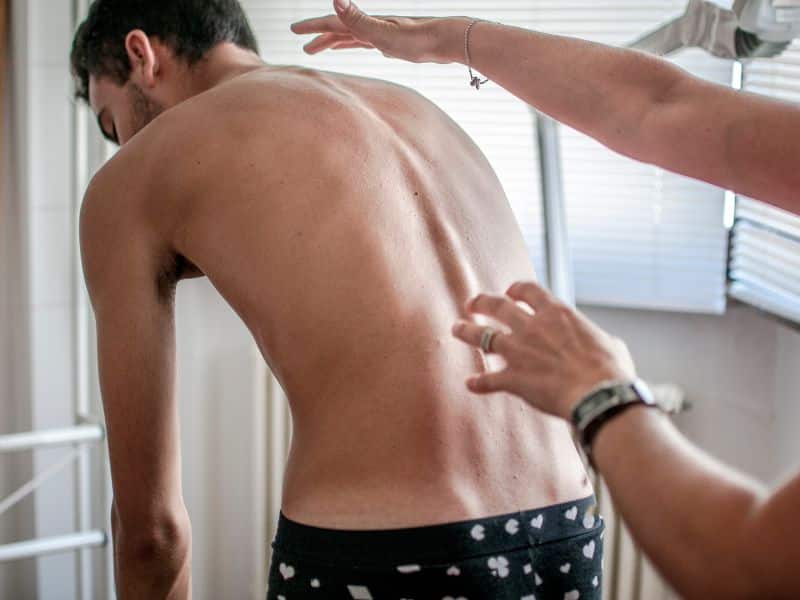Scoliosis hip pain is a common issue that affects many people. It occurs when the spine curves abnormally, which can cause discomfort and inflammation in the hips.
This condition can be caused by genetics, muscle imbalance, or injury to the back. People of any age or gender can experience scoliosis hip pain, but it is more common among older adults, adolescents, and those with a family history of the condition.
If you are experiencing pain in your hips due to scoliosis and would like to find relief, schedule a consultation with our expert healthcare professionals at Virgin Islands Neurology. Our neurologists will find a treatment plan that is tailored to your needs to relieve your scoliosis pain. Call our practice in the U.S. Virgin Islands today to schedule a consultation!

Scoliosis is a medical condition that causes abnormal spinal curvature. Scoliosis causes the lumbar spine (lower part of the spine) to curve from side to side in a sideways “S” or “C” shape.
This condition can cause pain and discomfort in other parts of the body, such as the hip area. Symptoms may include uneven shoulders, sacroiliac joint pain, pelvic dysfunction, visible curves in the spine when viewed from behind, or a raised hip on one side of the body.
There are three main types of scoliosis: congenital, idiopathic, and degenerative scoliosis. Congenital scoliosis is caused by a malformation in the bones of the spine at birth. Adolescent idiopathic scoliosis usually occurs in adolescents, with no known cause for the abnormal curves in their spine.

Degenerative scoliosis develops as people age due to changes that occur in the discs and joints of the back over time. Adult scoliosis patients may experience more severe symptoms that disrupt their daily lives.
If left untreated, scoliosis can cause pain and difficulty with everyday activities such as bending or reaching for objects. In severe cases, surgery may be needed to correct the curvature.
In its mildest form, scoliosis may cause no noticeable symptoms. However, if left untreated, things can worsen over time and result in pain and problems with posture and breathing.
The hip pain experienced by scoliosis sufferers usually occurs due to straining the iliolumbar and sacroiliac ligaments, which are strong bands of connective tissue that help stabilize the lumbosacral spine at the pelvis.
When scoliosis occurs, it can cause the spine to become misaligned and put pressure on different areas of the body. This can cause strain that radiates from the vertebrae down to the hips, resulting in pain.
Scoliosis can also cause changes in posture that result in further muscular tension and tightness, which can contribute to hip pain. Additionally, scoliosis can lead to decreased range of motion in the spine and hips, resulting in hip discomfort.
These symptoms may not always be immediately apparent after a diagnosis of scoliosis—they may progress over time as the curvature of the spine worsens or becomes more pronounced.
Hip pain caused by scoliosis can be difficult to recognize, as the symptoms are often subtle and vary depending on the severity of the condition. Common symptoms may include:
It is important to consult your doctor if you experience any of these symptoms to determine whether they are related to scoliosis.
While there is no cure for scoliosis itself, it is possible to manage its symptoms effectively with the right treatments. There are various ways to treat scoliosis-related hip pain, including non-surgical and surgical methods.
Physical therapy is the most common treatment option and can help improve flexibility and strength while reducing pain. Exercises may focus on strengthening the muscles around the hips, core stability exercises to reduce abnormal curvature, stretching of tight muscles, and improving posture.
Some non-surgical treatment methods for scoliosis-related hip pain include:
Surgery is one of the most common treatments for hip pain-related scoliosis. Different surgical procedures are used to treat this condition, typically depending on the severity of the curve and the age of the patient. Some common treatment options include:
Posterior Spinal Fusion (PSF): This surgery involves fusing together certain vertebrae in order to correct any curvature in the spine. The fusion is done using metal rods and screws, which hold the vertebrae in place as they heal. PSF can be used to treat both adults and children with scoliosis caused by hip pain.
Anterior Lumbar Interbody Fusion (ALIF): ALIF is a more complex procedure involving removing part of the disc to access and fuse together two adjacent vertebrae. The fusion removes any curvature in the spine and also stabilizes it. ALIF is typically used for adult patients with severe scoliosis caused by pain in the hip.
Vertebral Body Tethering (VBT): VBT involves attaching a tether to the affected vertebra, which slowly pulls it into a corrected position over time. This procedure is typically only used for very young patients who are still growing, as it allows for the correction of their spine without actually fusing any bones together.
Are you looking to relieve scoliosis hip pain? Then schedule a consultation with our expert healthcare physicians at Virgin Islands Neurology.
We will provide tailored scoliosis treatment for you to relieve pain in your hips. Contact our office located in the U.S. Virgin Islands today!

Schedule an Appointment
Address
Hours